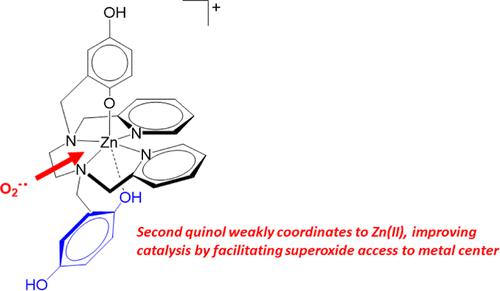当前位置:
X-MOL 学术
›
Inorg. Chem.
›
论文详情
Our official English website, www.x-mol.net, welcomes your feedback! (Note: you will need to create a separate account there.)
Diquinol Functionality Boosts the Superoxide Dismutase Mimicry of a Zn(II) Complex with a Redox-Active Ligand while Maintaining Catalyst Stability and Enhanced Activity in Phosphate Solution
Inorganic Chemistry ( IF 4.6 ) Pub Date : 2022-11-29 , DOI: 10.1021/acs.inorgchem.2c03256 Jamonica L Moore 1 , Julian Oppelt 2 , Laura Senft 2 , Alicja Franke 2 , Andreas Scheitler 3 , Meghan W Dukes 1 , Haley B Alix 1 , Alexander C Saunders 1 , Sana Karbalaei 1 , Dean D Schwartz 4 , Ivana Ivanović-Burmazović 2 , Christian R Goldsmith 1
Inorganic Chemistry ( IF 4.6 ) Pub Date : 2022-11-29 , DOI: 10.1021/acs.inorgchem.2c03256 Jamonica L Moore 1 , Julian Oppelt 2 , Laura Senft 2 , Alicja Franke 2 , Andreas Scheitler 3 , Meghan W Dukes 1 , Haley B Alix 1 , Alexander C Saunders 1 , Sana Karbalaei 1 , Dean D Schwartz 4 , Ivana Ivanović-Burmazović 2 , Christian R Goldsmith 1
Affiliation

|
In the current work, we demonstrate ligand design concepts that significantly improve the superoxide dismutase (SOD) activity of a zinc complex; the catalysis is enhanced when two quinol groups are present in the polydentate ligand. We investigate the mechanism through which the quinols influence the catalysis and determine the impact of entirely removing a chelating group from the original hexadentate ligand. Our results suggest that SOD mimicry with these compounds requires a ligand that coordinates Zn(II) strongly in both its oxidized and reduced forms and that the activity proceeds through Zn(II)-semiquinone complexes. The complex with two quinols displays greatly enhanced catalytic ability, with the activity improving by as much as 450% over a related complex with a single quinol. In the reduced form of the diquinol complex, one quinol appears to coordinate to the zinc much more weakly than the other. We believe that superoxide can more readily displace this portion of the ligand, facilitating its coordination to the metal center and thereby hastening the SOD reactivity. Despite the presence of two redox-active groups that may communicate through intramolecular hydrogen bonding and redox tautomerism, only one quinol undergoes two-electron oxidation to a para-quinone during the catalysis. After the formation of the para-quinone, the remaining quinol deprotonates and binds tightly to the metal, ensuring that the complex remains intact in its oxidized state, thereby maintaining its catalytic ability. The Zn(II) complex with the diquinol ligand is highly unusual for a SOD mimic in that it performs more efficiently in phosphate solution.
中文翻译:

Diquinol 功能促进 Zn(II) 络合物与氧化还原活性配体的超氧化物歧化酶模拟,同时保持催化剂稳定性并增强磷酸盐溶液中的活性
在目前的工作中,我们展示了显着提高锌络合物超氧化物歧化酶 (SOD) 活性的配体设计概念;当多齿配体中存在两个羟基时,催化作用增强。我们研究了喹诺酮影响催化作用的机制,并确定了从原始六齿配体中完全去除螯合基团的影响。我们的结果表明,SOD 与这些化合物的模拟需要一个配体,该配体可以强烈地协调氧化和还原形式的 Zn(II),并且活性通过 Zn(II)-半醌复合物进行。具有两个羟基的络合物显示出大大增强的催化能力,与具有单个羟基的相关络合物相比,活性提高了 450%。在二喹啉络合物的还原形式中,一种喹啉似乎比另一种更弱地与锌配位。我们相信超氧化物可以更容易地取代这部分配体,促进其与金属中心的配位,从而加速 SOD 反应。尽管存在两个可以通过分子内氢键和氧化还原互变异构进行交流的氧化还原活性基团,但只有一个对苯二酚经历双电子氧化成催化过程中的对醌。对醌形成后,剩余的喹啉去质子化并与金属紧密结合,确保络合物在其氧化状态下保持完整,从而保持其催化能力。Zn(II) 与二喹啉配体的复合物对于 SOD 模拟物来说是非常不寻常的,因为它在磷酸盐溶液中表现更有效。
更新日期:2022-11-29
中文翻译:

Diquinol 功能促进 Zn(II) 络合物与氧化还原活性配体的超氧化物歧化酶模拟,同时保持催化剂稳定性并增强磷酸盐溶液中的活性
在目前的工作中,我们展示了显着提高锌络合物超氧化物歧化酶 (SOD) 活性的配体设计概念;当多齿配体中存在两个羟基时,催化作用增强。我们研究了喹诺酮影响催化作用的机制,并确定了从原始六齿配体中完全去除螯合基团的影响。我们的结果表明,SOD 与这些化合物的模拟需要一个配体,该配体可以强烈地协调氧化和还原形式的 Zn(II),并且活性通过 Zn(II)-半醌复合物进行。具有两个羟基的络合物显示出大大增强的催化能力,与具有单个羟基的相关络合物相比,活性提高了 450%。在二喹啉络合物的还原形式中,一种喹啉似乎比另一种更弱地与锌配位。我们相信超氧化物可以更容易地取代这部分配体,促进其与金属中心的配位,从而加速 SOD 反应。尽管存在两个可以通过分子内氢键和氧化还原互变异构进行交流的氧化还原活性基团,但只有一个对苯二酚经历双电子氧化成催化过程中的对醌。对醌形成后,剩余的喹啉去质子化并与金属紧密结合,确保络合物在其氧化状态下保持完整,从而保持其催化能力。Zn(II) 与二喹啉配体的复合物对于 SOD 模拟物来说是非常不寻常的,因为它在磷酸盐溶液中表现更有效。


























 京公网安备 11010802027423号
京公网安备 11010802027423号